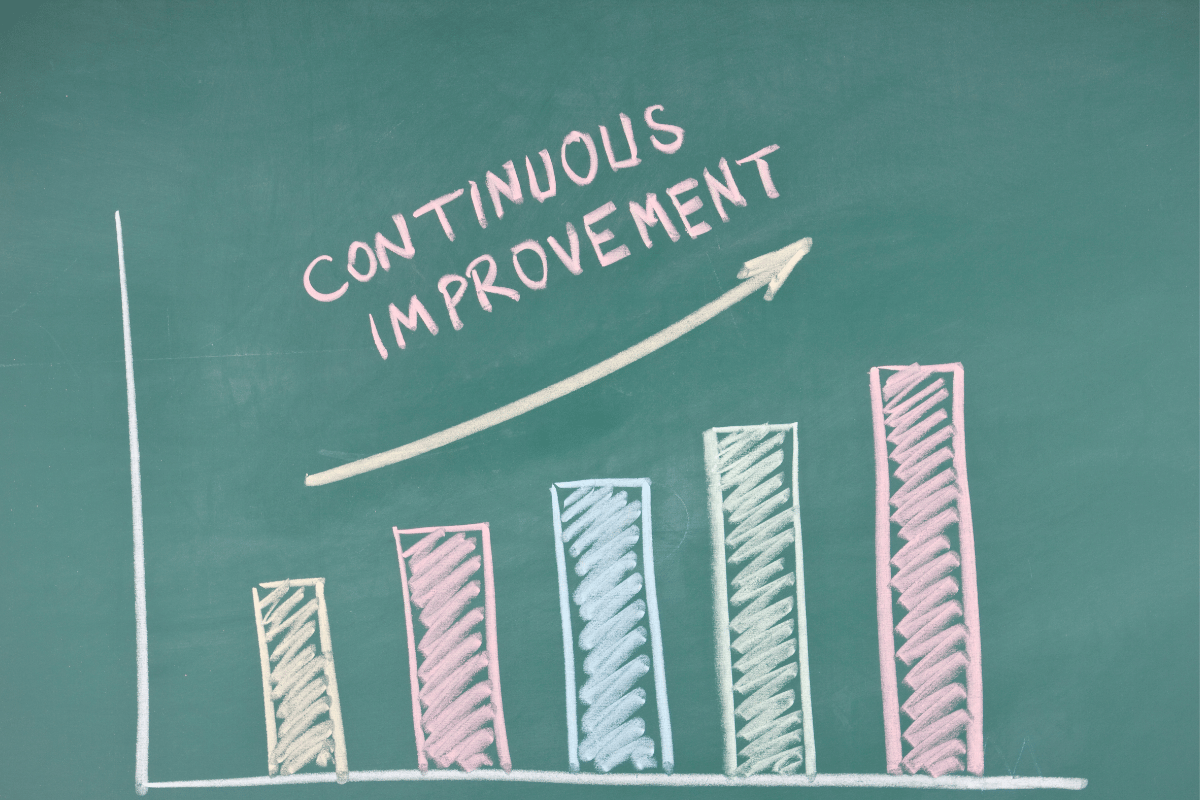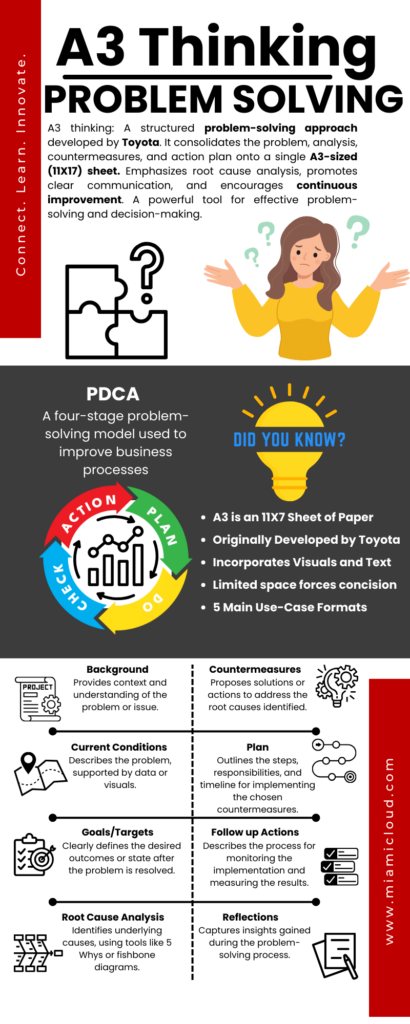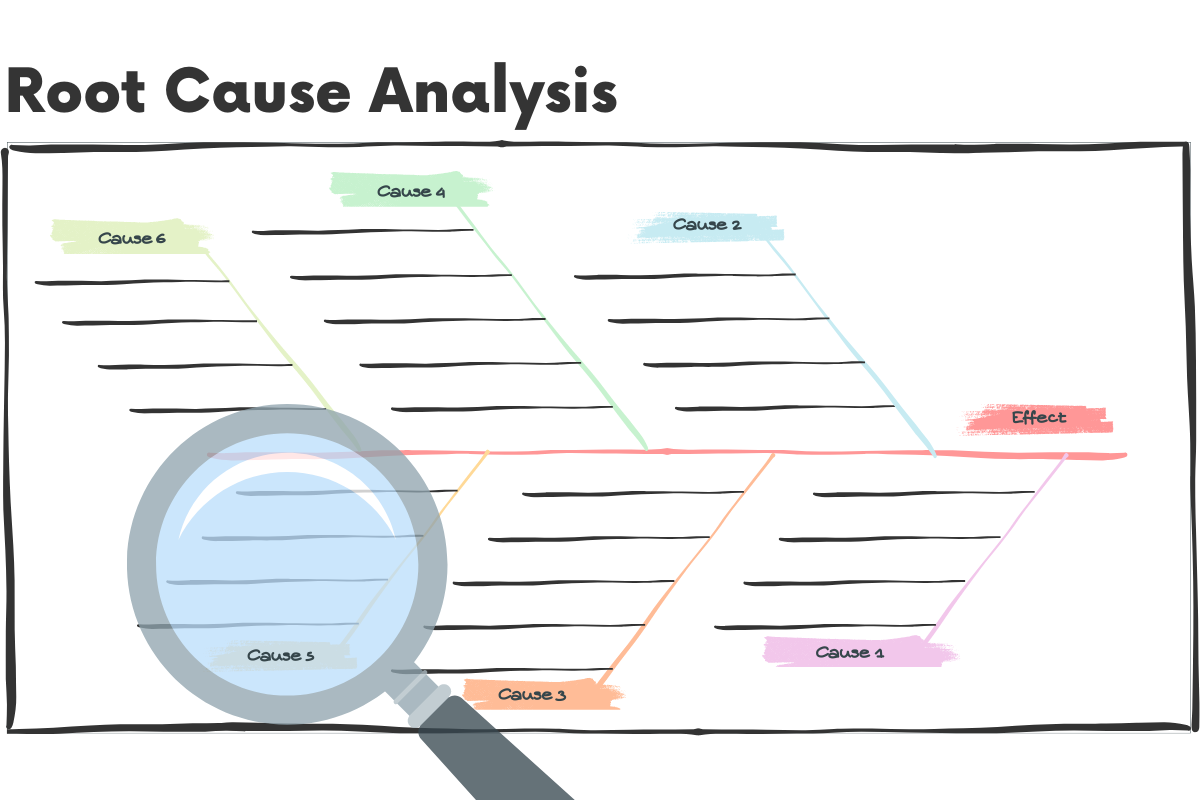A3 Thinking: A Step-by-Step Guide to Problem Solving
In today’s fast-paced and complex business world, problem-solving skills are more important than ever. Whether you’re a manager, team leader, or simply looking to enhance your problem-solving abilities, A3 Thinking is a valuable tool to have in your toolkit. This structured approach is derived from the lean management philosophy and provides a step-by-step guide to effectively identify, analyze, and solve problems. In this article, we will explore what A3 Thinking is, how it works, and how to use it to solve problems in your organization.
So, let’s dive in and uncover the power of A3 Thinking!
A3 thinking in simple terms is a structured continuous improvement methodology to analyze and solve problems that blends both text and visual components. “A3” refers to the A3-sized (11X17) sheet of the paper used to concisely document the thinking process,
Key Takeaways
- A3 Thinking simplifies complex problem-solving onto a single A3 sheet, following lean management principles.
- It employs root cause analysis tools like the 5 Whys, ensuring thorough problem understanding.
- Encourages team collaboration across functions for diverse solution perspectives.
- The A3 report documents the problem-solving process, aiding clear communication.
- Promotes continuous improvement by iterating on solutions for better outcomes.
Value of this Article
Why Keep Reading? The Payoff’s Worth Its Weight
Staying plugged in unlocks a treasure trove of game-changing insights. We’re talking a total mindset shift when it comes to mastering problems. The strategies outlined in this guide aim to provide a structured approach and practical insights proving their worth.
By investing a few minutes, you’ll walk away with a fresh perspective on turning obstacles into opportunities. Problems that used frustrate will start feeling more manageable. That nagging sense of being stumped? It’ll be replaced by a newfound confidence in your abilities to conquer whatever lies ahead.
Understanding the A3 Problem Solving Approach
A3 thinking is a powerful methodology for problem-solving and continuous improvement. It provides a systematic approach for analyzing and resolving issues, helping organizations to achieve better outcomes. By understanding and applying the basics of A3 thinking, individuals and teams can become more efficient and effective in their problem-solving endeavors.
The A3 Thinking Process: An Overview
A3 thinking is a problem-solving approach that was popularized by Toyota and is widely used in Lean management practices. It gets its name from the metric size of the paper it is typically documented on: A3. A3 thinking provides a structured framework for analyzing and addressing problems, making it an effective tool for continuous improvement.
Identifying the Problem
So, how to use A3 thinking? The process begins with identifying a problem and gathering all relevant information about it. This includes data, observations, and input from those involved. The next step is to analyze the root causes of the problem, using tools such as the 5 Whys or fishbone diagrams. This helps to determine the underlying factors contributing to the issue.
Analyzing Root Causes
Once the root cause is identified, the next phase involves developing potential solutions. It is important to consider multiple options and evaluate their potential impact. This step is often done collaboratively, involving cross-functional teams to ensure diverse perspectives. After evaluating the alternatives, a decision is made on the most viable solution.
Action Plan Development
The final step in A3 thinking is to devise an action plan for implementing the chosen solution. This includes defining specific actions, assigning responsibilities, and setting targets for improvement. Regular monitoring and reviews are incorporated to track progress and assess the effectiveness of the implemented solution.
A3 Project Solving Layout
The A3 report is typically divided into sections that are laid out on an A3-sized (about 11×17 inches) sheet of paper. The layout can vary, but a common approach is to use both the left and right sides of the sheet to guide the reader through the problem-solving process in a logical flow.
This layout helps to visually guide the reader through the problem-solving process, making it easier to understand the logical flow from problem identification to reflection on the outcomes and learnings. The A3 report serves as both a communication tool and a documentation of the problem-solving effort, facilitating collaboration and continuous improvement.
A3 Report Sections Explained
Here’s a breakdown of where each section might be placed and what it includes:
Left Side of the A3 Report:
-
-
-
-
-
-
-
-
- Background (Top Left)
- Provides context and understanding of the problem or issue.
- Explains why the problem needs to be addressed.
- Current Condition (Below Background)
- Describes the problem in detail, often supported by data or visual evidence.
- Shows the gap between the current state and the desired state.
- Goals/Target Condition (Below Current Condition)
- Clearly defines the desired outcomes or state after the problem is resolved.
- Sets specific, measurable objectives to achieve.
- Root Cause Analysis (Bottom Left)
- Identifies the underlying causes of the problem.
- Common tools include the 5 Whys or fishbone diagrams.
- Background (Top Left)
-
-
-
-
-
-
-
Right Side of the A3 Report:
-
-
-
-
-
-
-
-
- Countermeasures (Top Right)
- Proposes solutions or actions to address the root causes identified.
- May include several potential countermeasures for consideration.
- Implementation Plan (Below Countermeasures)
- Outlines the steps, responsibilities, and timeline for implementing the chosen countermeasures.
- Includes who is responsible for each action and when it will be completed.
- Follow-up Actions and Results (Below Implementation Plan)
- Describes the process for monitoring the implementation and measuring the results.
- Compares the actual outcomes to the goals/target condition to assess effectiveness.
- Reflections/Learnings (Bottom Right)
- Captures insights gained during the problem-solving process.
- Identifies what worked well, what didn’t, and opportunities for future improvements.
- Countermeasures (Top Right)
-
-
-
-
-
-
-
Define the Problem Statement Clearly
In any problem-solving process, one of the most critical steps is to define the problem statement clearly. Without a clear problem statement, it becomes nearly impossible to come up with effective solutions. So, what exactly does it mean to define the problem statement clearly?
The Importance of a Clear Problem Statement
First and foremost, a clear problem statement articulates the specific issue or challenge that needs to be addressed. It provides a concise and focused description of the problem at hand. This clarity helps in ensuring that everyone involved is on the same page, which is crucial for successful problem-solving.
One effective methodology that can be used to define the problem statement clearly is through the use of A3 thinking. The A3 process is a problem-solving approach that originates from the Toyota Production System and is widely used in various industries. It involves using the A3 template to capture the problem, analyze its root causes, and propose countermeasures.
Utilizing A3 Thinking to Define the Problem
To define the problem statement using A3 thinking, one must start by gathering all the relevant information related to the problem. This includes data, observations, and feedback from those affected by the problem. Then, it is essential to analyze the information and identify the underlying causes that contribute to the problem. This step helps in understanding the root causes and ensures that the problem is not merely being addressed superficially. Finally, the problem statement should be clear, concise, and actionable, highlighting the desired outcomes and the impact the problem is having on the organization.
Defining the problem statement clearly is a crucial step in the problem-solving process. It helps in aligning all stakeholders and sets the stage for finding effective solutions. Applying A3 thinking can be a valuable tool in this endeavor, as it provides a structured approach to capturing, analyzing, and proposing countermeasures for the identified problem. By utilizing A3 thinking and taking the time to define the problem statement clearly, organizations can improve their problem-solving effectiveness and drive positive change.
Conducting Root Cause Analysis with A3 Thinking
Once the problem is clearly identified, the next step is to conduct a root cause analysis. This involves asking “why” multiple times (5 Whys is an actual methodology) to understand the underlying causes of the problem. By getting to the root cause, it becomes possible to implement effective countermeasures and prevent the issue from recurring. A3 thinking provides a structured framework for brainstorming and analyzing potential root causes, ensuring that all possibilities are explored.
Initiating Root Cause Analysis
When faced with a problem or an issue, it’s important to dig deep and find the root cause, rather than just addressing the surface-level symptoms. Conducting a root cause analysis is a crucial step in identifying and solving the problem effectively. And one effective tool that can be used for this purpose is A3 thinking.
The A3 problem solving methodology that helps to structure and guide the root cause analysis process. Derived from the A3 paper size (11×17 inches), it provides a concise and visual approach to problem-solving. The A3 format consists of various sections, including problem identification, current state analysis, root cause analysis, future state planning, and action plan implementation.
Utilizing Analytical Methods for Root Cause Analysis
To start conducting a root cause analysis with A3 thinking, it’s important to clearly articulate the problem or issue at hand. This involves gathering data, identifying trends, and understanding the impact on the overall process or system. By documenting the problem in the A3 format, it becomes easier to communicate and work collaboratively with others involved in the analysis.
Developing Countermeasures and Solutions
A3 thinking is a problem-solving methodology that originated from the Toyota Production System. It emphasizes the use of a single A3-sized sheet of paper to document the problem, analyze the root cause, and propose countermeasures. This visual approach promotes clarity, collaboration, and efficient decision-making.
Define Clear Problem Statement
To effectively use A3, which is a “lean thinking tool”, one must follow a structured process. First, define the problem clearly and concisely. This step involves identifying the gap between the current state and the desired state. Once you have a good understanding and the problem is defined, it is essential to conduct a thorough root cause analysis. This involves identifying all possible causes and determining the most significant contributor to the problem.
Brainstorming Potential Solutions
Next, brainstorm potential solutions and select the most viable one. A3 thinking encourages collaboration and involving key stakeholders in this decision-making process. Once a countermeasure is chosen, it is crucial to create an action plan, outlining the steps, responsibilities, and timelines involved in implementing the solution. Regular monitoring and evaluation of the countermeasure’s effectiveness are also vital to ensure continuous improvement.
Selecting and Planning Countermeasures
Developing countermeasures and solutions is an essential aspect of problem-solving in any field. Whether it’s in business, technology, or personal circumstances, having effective strategies in place can make a significant difference in resolving challenges effectively. One crucial tool that can aid in this process is A3 thinking.
Implementing and Monitoring Progress
Implementing new strategies or making changes in any organization can be a challenging task. However, with the right approach, it is possible to effectively implement new initiatives and monitor progress along the way. One popular tool that can help with this process is known as A3 thinking.
A3 thinking is a problem-solving methodology that guides individuals and teams through a structured process of identifying issues, developing countermeasures, and monitoring the progress of those countermeasures. It takes its name from the standard paper size used for documenting the entire problem-solving process in this method. By utilizing A3 thinking, organizations can bring clarity to complex problems and encourage collaboration, resulting in effective implementation and continuous improvement.
Executing the Action Plan
To use A3 thinking, first, clearly define the problem and gather relevant data. Then, analyze the root causes and identify potential solutions. It is important to involve cross-functional teams in this step to gain different perspectives and expertise. After selecting the best solution, create an action plan with measurable goals and assign responsibilities to team members. This plan should include a timeline and metrics to monitor progress.
Monitoring and Assessing Progress
The monitoring phase is crucial as it allows for real-time adjustments and ensures that the implemented solution is achieving the desired results. Regular check-ins and progress updates should be conducted to review the status of the action plan and address any potential roadblocks. By monitoring progress, teams can identify areas of improvement or need for further adjustments, leading to successful implementation and sustained progress.
Evaluating Results and Adjusting as Needed
When it comes to evaluating results and making necessary adjustments, the concept of A3 thinking can be a valuable tool. A3 thinking, derived from the popular lean management approach, is a problem-solving process that encourages analysis and continuous improvement. By using this method, individuals and teams can effectively evaluate the outcomes of their efforts and make the necessary adjustments to achieve better results.
Assessing Outcomes with A3 Thinking
The first step in evaluating results using A3 thinking is to clearly define the problem or objective. This involves gathering data, analyzing it, and identifying the root causes of any issues or challenges. By understanding the underlying factors, individuals and teams can gain insights into why certain results were achieved.
Once the problem is defined, the next step is to develop a plan for improvement. This involves setting goals and objectives, determining the actions needed to achieve them, and establishing a timeline for implementation. By clearly outlining these steps and assigning responsibilities, individuals and teams can have a structured approach to measuring improvement.
Iterative Improvement: Analyzing and Refining Solutions
After implementing the plan, it is crucial to collect data and monitor progress. This can be done through regular check-ins, key performance indicators, or any other suitable measurement methods. By tracking results and comparing them to the desired outcomes, individuals and teams can assess whether the implemented changes are effective in achieving the intended improvements.
Based on the results and key findings, adjustments can be made as needed. This may involve revisiting the initial problem statement, modifying the action plan, or reallocating resources. The goal is to continuously iterate and improve upon the process until the desired results are achieved.
Communicating Findings and Recommendations
Effective communication of findings and recommendations is essential in any business or decision-making process. By clearly conveying the results of analysis, companies are able to make well-informed decisions and take appropriate actions. One effective way to communicate findings and recommendations is through the use of A3 thinking.
Leveraging A3 Thinking for Effective Communication
When using A3 thinking to communicate findings and recommendations, it is important to start by clearly defining the problem or objective. This sets the context for the analysis and ensures that everyone is on the same page. Next, present the facts and data that have been collected and analyzed. This is an opportunity to provide evidence and support for the findings and recommendations being made.
Crafting the A3 Report: A Tool for Clarity and Engagement
The A3 report should also clearly outline the proposed countermeasures or solutions. This includes detailing the action plan, responsible parties, and anticipated outcomes. By presenting the recommendations in a structured and visual format, it becomes easier for stakeholders to understand and align their efforts accordingly.
Continuous Improvement with A3 Thinking

Continuous improvement is a key aspect of any successful organization, as it allows for the identification and resolution of issues that may hinder progress and efficiency. One effective tool that can be used to drive continuous improvement is A3 thinking. A3 thinking is a problem-solving and communication approach that was originally developed by Toyota, and it has since been adopted by many organizations across various industries.
The A3 Thinking Framework: From Problem Identification to Solution Development
To use A3 thinking effectively, it is important to follow a step-by-step process. The first step is to clearly define the problem or challenge. This involves gathering relevant information, analyzing data, and understanding the root causes of the issue. The next step is to brainstorm potential solutions or countermeasures. It is important to involve all stakeholders in this step, as diverse perspectives can lead to more innovative and effective solutions. Once potential solutions have been identified, they can be evaluated and prioritized based on their feasibility and expected impact.
Implementing Solutions and Ensuring Continuous Improvement
After a solution has been selected, it is important to develop a detailed action plan to implement this solution. This includes assigning responsibilities, setting deadlines, and establishing key performance indicators to measure progress. Throughout the implementation process, it is essential to monitor and evaluate the effects of the solution, and to make adjustments as necessary. By following this structured approach, organizations can effectively drive continuous improvement and achieve better results.
Frequently Asked Questions
What is problem solving with A3 thinking?
Problem solving with A3 thinking is a structured approach to identifying, analyzing, and resolving problems through the use of the A3 process, typically involving capturing the key elements of a problem on a single sheet of paper.
What is the A3 process?
A3 process is a problem-solving methodology that follows a specific format for problem identification, root cause analysis, countermeasure development, and action planning, all presented on a single A3-sized sheet of paper.
Why is the A3 report important in problem solving?
The A3 report serves as a visual tool that helps teams document and communicate their problem-solving process, facilitating understanding, collaboration, and decision-making.
How does A3 thinking help in identifying root causes?
A3 thinking encourages a systematic approach to problem solving by focusing on understanding the current situation, asking probing questions, and using tools like the 5 Whys to uncover the root cause of the problem.
What is the relationship between A3 problem solving and continuous improvement?
A3 problem solving is deeply integrated with continuous improvement methodologies like Lean thinking and the Toyota Production System, emphasizing the importance of addressing issues at their root to drive ongoing improvement.
Conclusion:
A3 Thinking equips individuals and organizations with a systematic approach to problem-solving, rooted in the principles of Lean management. By guiding users through problem identification, root cause analysis, solution development, and action plan implementation, it facilitates clear communication and collaborative decision-making. Embracing A3 Thinking can significantly enhance problem-solving capabilities, driving continuous improvement and fostering a culture of efficiency and innovation.
If you liked this article, remember to subscribe to MiamiCloud.com. Connect. Learn. Innovate.








